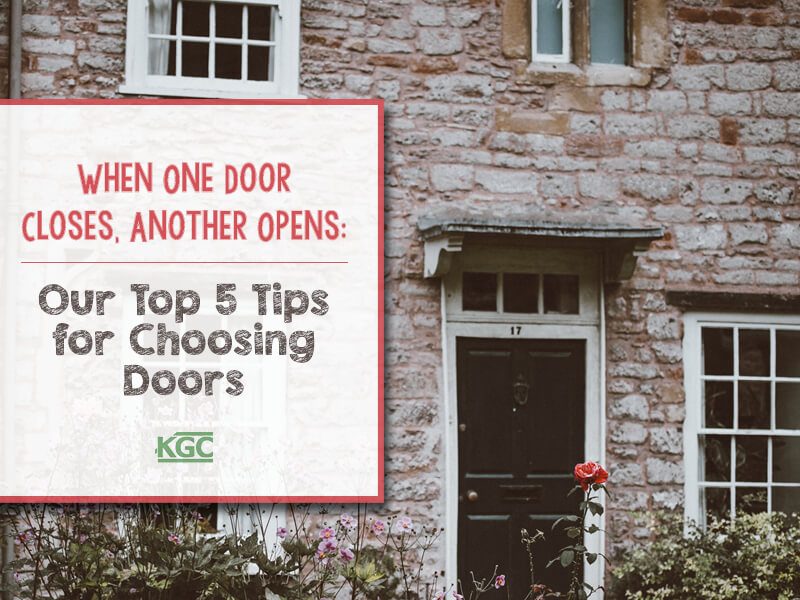“Every wall is a door.”
Have you ever walked past the gigantic bronze doors of the 100-year-old US National Bank Building in Portland, Oregon, and thought they look quite…old?
Not surprising, since they were inspired by the antique bronze doors of Greek and Roman temples.
In fact, we haven’t moved very far from those designs since then: contemporary doors still have the same basic design of vertical beams, horizontal beams, and locks.
It’s a classic.
Good designers know the aesthetic value of a high-quality door. It’s the crowning glory of a renovation project.
Of course, style isn’t the only reason to replace your door – if it’s old and worn, it could be letting heat escape, decreasing the energy efficiency of your house and increasing your energy bills.
But how do you choose the right one for your home?
Start with these five tips!
1: Budget for the extras
You’ll have a wide range of options when you’re buying your doors, from choosing materials and styles to whether to buy a single door leaf or door set.
A door leaf – just the door – may sound cheaper, but once you factor in the door frame, hinges, lock, and handle, you may be better off buying the door set.
Our tip: Consider buying all your doors at once – many suppliers will offer discounts for bigger orders. And use most of your budget for the exterior door, where you’ll have the most bang for your buck. Then spend the rest on the most visible interior doors; with the cheapest doors on the upper floors, where guests don’t see them.
2: Go for as high quality as your budget allows
The quality of your door should be your foremost consideration.
With Oregon’s winters, insulation is really important. Any gaps in your front door or door frame will let the heat out and the cold in. Replacing your doors with a new, well-fitted energy efficient ones will have a positive impact on your wallet as well.
Wood is always a favorite for doors, but it can also be affected by rain and sun, and could crack or warp. Cheap wooden doors won’t last as long and will need more maintenance. If you’re looking at wooden doors especially, aim for the highest quality you can afford.
Our tip: You door works double-duty, keeping the heat in and the noise out. A good quality door will keep your home safe – and stylish – for years to come. Invest in solid, beautiful exterior and interior doors that will set the tone for your décor and give you the instant wow factor.
3: Choose the right material, style, and finish
A humble door is the one item that can have an enormous impact on the look of your house, inside and out. It seems obvious, but many people make the mistake of buying doors for their style or quality but forget how it’ll fit into the overall design of their house.
Whether you have an Oregon period house, a country cottage, or a contemporary apartment, consider how the door complements or enhances the architectural style of the house.
Doors should match the flooring and windows, rather than the other way around. It’s much easier to change the soft furnishings to match a door than to change the doors to match the décor.
Your choice of material can also be guided by how much use that door will get. Solid core wooden doors have the heaviness of that lovely ‘thud’ when you close the door. Wood veneer is more affordable but won’t be as high quality. You can also look for fiberglass or steel doors (not as ugly as they sound!).
Our tip: Internal glazing is great for darker rooms with small windows. It’s a great way to bring in more light without losing insulation or privacy (opt for frosted glazing). These are great options for home offices or conservatories.
4: Get it fitted by a professional
Our tip: Installing a door seems like it should be simple, but it can lead to a lot of drama. It’s easier to get a professional to do it.
Here’s what can go wrong:
- Measuring the door opening wrong. There’s nothing worse than coming home from the home store with new doors only to realize that there’s not enough space for the lining, or that the door is too thick and blocks access when it opens.
- Installing a door level but not taking into account that a wall or floor isn’t. That’s why some doors always swing closed or get stuck when opened. The door may have to be adjusted so it fits just right.
- And speaking of not shutting properly, the wrong sized screws over time can cause the door to scrape. If they’re not screwed in just right, the screws could also cause the door to warp.
- And there’s more! Installing the shins improperly will also cause the door to shut badly.
- Not getting the reveals even, which will also cause the door to warp over time.
5: Keep security in mind
A good quality door will make your home more secure.
Exterior doors need solid-core, not hollow, construction, to make them stronger and more resistant to break-ins.
Loft and garage doors should be fire resistant, at the very least. But you can also invest more for fire-resistant interior doors, which will slow down the spread of a potential fire.
If you’re buying door sets, make sure the lock that’s included is of high quality. Look for anti-pick, anti-drill, anti-snap, and anti-bump. That’s a lot of antis, but it’ll also make your house more anti-burglar!
Some people like to have glass on their front door to let the light in – but if you’re doing this, make sure the glass is at the very top of the door. Consider wooden doors with carvings, which will make your front door more secure.
Our tip: Add extra security features like smart doorbells and smart locks. With the help of a little technology, keyless entry and video-calling on exterior doors can put you in control of who’s coming in and out of your home.


